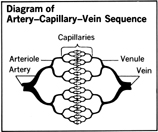The Circulatory System, the Heart, and Blood - The heart and circulatory network
Perhaps the best way to put the heart in perspective is to place it where it belongs, at the hub of the body's circulatory system. This hollow, fist-sized lump of sinewy tissue is located behind the breastbone, centered just about at the vertical midline of our chest. It is connected into a closed system of flexible tubes, called blood vessels, ranging down from finger-thick to microscopically slender, that reach into every cavern, crevice, and outpost of our body—a network of some 70,000 miles.
The heart has essentially one function—to push blood, by pumping action, through this enormous network of blood vessels. We have about six quarts of blood in our body, pumped at the rate of about five ounces every time the heart beats (normally about 72 times a minute for an adult), which we feel as our pulse. The blood circulates and recirculates through the blood vessels, pushed along by the pumping of the heart.
Arteries and Veins
The blood vessels are generally described as arterial , referring to the arteries that carry blood away from the heart; or venous , referring to the veins through which blood seeps and flows back toward the heart to be re-pumped. A large artery such as the aorta branches into smaller arteries, and these eventually into still smaller vessels called arterioles , and the arterioles, finally, into the smallest blood vessels, the capillaries . These in turn open onto other capillaries, which are the starting point for the return of blood to the heart.

The microscopic capillaries typically form a kind of cat's cradle connection, sometimes called a capillary bed, at the transition zone where arterial blood becomes venous blood. The returning blood moves from the capillaries to small veins called venules (the counterparts of arterioles) and through successively larger veins back to the heart.

Comment about this article, ask questions, or add new information about this topic: